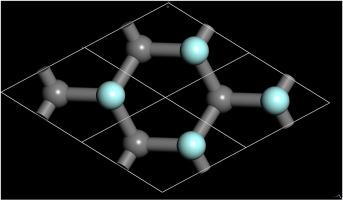Structure and spectroscopy of graphite monofluoride
IF 11.6
2区 材料科学
Q1 CHEMISTRY, PHYSICAL
引用次数: 0
Abstract
The structure of graphite monofluoride, (CF)n, has been debated since its discovery in 1934. In this work, we investigate a commercial graphite monofluoride by vibrational spectroscopy (infrared, Raman and the first inelastic neutron scattering spectra of this material). The spectroscopy shows that the material contains unreacted graphite and the partially fluorinated product dicarbon fluoride, (C2F)n, We evaluate the previously proposed and structures using computational methods and find F···F contacts render the structure dynamically unstable. We propose two alternative structures, and , generated by displacement of one layer relative to another and find that is also dynamically unstable. The calculations are validated by comparison of calculated and observed INS spectra

单氟化石墨的结构和光谱学
单氟化石墨(CF)n的结构自1934年发现以来一直存在争议。在这项工作中,我们通过振动光谱(该材料的红外、拉曼和第一非弹性中子散射光谱)研究了一种商业单氟化石墨。光谱分析表明,材料中含有未反应的石墨和部分氟化产物氟化碳(C2F)n,我们用计算方法对之前提出的P6 - m2和P3 - m1结构进行了评价,发现F···F接触使得P6 - m2结构动态不稳定。我们提出了两种替代结构,Cmc21和P63mc,由一层相对于另一层的位移产生,并发现Cmc21也是动态不稳定的。计算结果与观测结果进行了比较,验证了计算结果的正确性
本文章由计算机程序翻译,如有差异,请以英文原文为准。
求助全文
约1分钟内获得全文
求助全文
来源期刊

Carbon
工程技术-材料科学:综合
CiteScore
20.80
自引率
7.30%
发文量
0
审稿时长
23 days
期刊介绍:
The journal Carbon is an international multidisciplinary forum for communicating scientific advances in the field of carbon materials. It reports new findings related to the formation, structure, properties, behaviors, and technological applications of carbons. Carbons are a broad class of ordered or disordered solid phases composed primarily of elemental carbon, including but not limited to carbon black, carbon fibers and filaments, carbon nanotubes, diamond and diamond-like carbon, fullerenes, glassy carbon, graphite, graphene, graphene-oxide, porous carbons, pyrolytic carbon, and other sp2 and non-sp2 hybridized carbon systems. Carbon is the companion title to the open access journal Carbon Trends. Relevant application areas for carbon materials include biology and medicine, catalysis, electronic, optoelectronic, spintronic, high-frequency, and photonic devices, energy storage and conversion systems, environmental applications and water treatment, smart materials and systems, and structural and thermal applications.
 求助内容:
求助内容: 应助结果提醒方式:
应助结果提醒方式:


